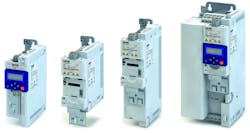For the past four years we've been seeing a number of business partnerships develop to help companies deliver on a broad swath of Industrial Internet of Things (IIoT) and Industry 4.0 concepts. And over the past year or so, we’ve witnessed the introduction and redesign of several products with IIoT or Industry 4.0 in mind. Rest assured, you can expect the number of IIoT-influenced product designs to increase exponentially in the coming years.
At the SPS/IPC/Drives show in Nuremberg last November, Lenze was among the exhibitors prominently promoting the Industry 4.0 readiness of its new products, in particular its new i500 series of frequency inverters.
Bernd Müller, Lenze’s inverter product manager, said the i500 represents “more than just a facelift for an existing range of inverters—it is a radical new development. We have been very stringent in selecting only the latest available components for this new device.”
Those components include new IGBT (insulated gate bipolar transistor) technology, a steplessly controlled fan, and active balancing of the intermediate circuit voltages. Müller says the combination of these technologies helps keep the inverters’ energy consumption as low as possible.
In terms of the i500’s Industry 4.0 applicability, Lenze’s director of innovation, Frank Maier, explained how this capability emerged out of the inverter self-parameterizing trend that has been ongoing in the automation industry for the past several years. “In the past, [inverter self-parameterization] led to the electronic nameplate, which is a development Lenze did not adopt,” said Maier, “because the production costs of standard three-phase AC motors cannot cover an electronic component that costs five to 10 euros. Today, however, we have the option of installing 10 cent RFID chips in a conventional motor nameplate that can be read with NFC (near field communication). With an NFC-capable smartphone, a user can download the motor parameters via the Lenze Smart Motor app and import them into the i500 using a wireless LAN. Once the inverter has the motor data, it can switch into a more efficient mode.”
This app-enabled inverter self-parameterization can be used to affect parameters such as adjusting the magnetizing current of the motor for a partial load. Maier pointed out that Lenze enables this with its VFCeco function in the Lenze Smart Motor.
Beyond the i500’s Industry 4.0 readiness, Lenze emphasizes the inverter’s small size as a benefit to OEMs and system designers. Müller noted that the ability to increase power density has enabled the inverters to become smaller and, because of the inverters’ lower heat losses and Lenze’s cooling system, they can be installed side by side in a control cabinet. “Up to the 11 kW power level, the i500 series fits in the popular flat 150 model control cabinets,” Müller said. He added that, in the series power range from 0.25 to 45 kW, the i500 meets the EN 50598-2 class IE2 efficiency standard that will soon come into force.
Another feature of the i500 is the ability to separate the i500’s power section from the control unit. “The control unit is snapped onto the power section and contains different forms of fieldbus communication, including Ethernet, multiple I/O interfaces, plug options for a keypad, and a USB interface or wireless LAN module,” said Müller. “These interfaces are available as options for commissioning, setting parameters or diagnosis. The wireless LAN module communicates with a PC or the Lenze keypad app on a smartphone.”
Müller explained that these features of the i500 were “deliberately designed” as such “to enable customers to place an order for an i500 with the exact features they need.”
Leaders relevant to this article:


